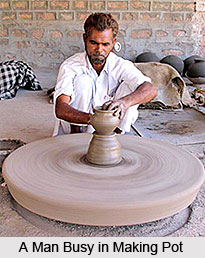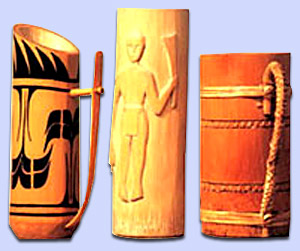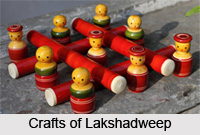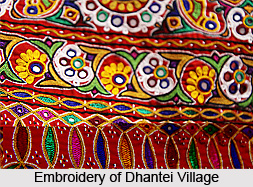 Kumhar or Kumbhar is also known as the Prajapati. Kumhar, the caste of potters, mostly belong to the Hindu Community. The term `Kumhar` means potter and they trace their descent to Prajapati, the son of Lord Brahma. The word Prajapati, which literally means `Lord of the People`, refers to the very first potter god created to make the vessels required for containing food. The Kumhars or Kumbhars has been derived from the Sanskrit word `Kumbhakar`, which literally means earthen pot. Kumhars are mostly found in the northern and eastern region of the country. Kumhar caste is an ancient caste, references of which have been found in old Hindu scriptures. Some of the old Hindu texts trace the origin of Kumhar caste from the mixed marriage within the four prevalent castes of the society.
Kumhar or Kumbhar is also known as the Prajapati. Kumhar, the caste of potters, mostly belong to the Hindu Community. The term `Kumhar` means potter and they trace their descent to Prajapati, the son of Lord Brahma. The word Prajapati, which literally means `Lord of the People`, refers to the very first potter god created to make the vessels required for containing food. The Kumhars or Kumbhars has been derived from the Sanskrit word `Kumbhakar`, which literally means earthen pot. Kumhars are mostly found in the northern and eastern region of the country. Kumhar caste is an ancient caste, references of which have been found in old Hindu scriptures. Some of the old Hindu texts trace the origin of Kumhar caste from the mixed marriage within the four prevalent castes of the society.
The kumbhars or the kumhars also have a strong mythological connection. According to mythology, the kumhars or kumbhkars are the descendants of Lord Prajapati Daksha. Lord Prajapati Daksha was a scholar in Yajur Veda and once he had decided to arrange for a Yajna. He had invited all the muni, rishis to the Yajna. In the Yajna, Lord Shiva and Lord Brahma were present but they were the only ones who did not stand up as Prajapati entered. At this Prajapati got angry. He said Lord Shiva would not be allowed to take part in the Yajna. On the other hand Nandi, the gatekeeper of Shiva cursed Prajapati and said that his entire lineage will be considered non-Brahmin in spite of belonging to a high Brahmin order. Another mythological record says that the first earthen pot or the kumbh was a gift from the gods. While the gods were churning out nectar from the sea they did not have a pot where they could store the ambrosia. Therefore, at that time Lord Vishwakarma picked up some earth and prepared a pot. The kumhars believe that it was their first creation of pot.
It is also believed that the wheel, the stick for turning the wheel, the cone of clay from which pots are thrown, the thread which cuts the pot from the wheel, are all symbols of creation, and are believed to have been given to the potter by the gods as the tools of his trade. Prajapati is someone who works with the basic elements of earth, water and fire which are considered sacred by Hindus. He creates vessels used in many religious ceremonies and as such is a revered and respected member of the village. In many communities he even acts as an intermediary priest communicating directly with god, and is sometimes known as Bhagat or pious man.
Kumhars have various sub-castes, some of which are of territorial types. Like for instance, they are the Malwi from Malwa, Maratha from the Maratha region, Pardeshi from northern parts of the country and Telenga from Hyderabad. Further, some endogamous groups of Kumhars have arisen because of the difference in the mode of working. Hathgarhia make vessels using their hands, Kurere make vessels by using a stone slab which revolves on a stick instead of a wheel, Goria only mould either red or white vessels and no black pots, and lastly the Chakere use wheels for moulding pots in a locality where the other Kumhars do not use any wheel.
The potter community is patriarchal so that name, position and possessions are inherited by its male members. There are strict divisions of labour between the sexes which may have slight geographical variations, but basically women are responsible for the areas of clay preparation and decoration and also assist with clay collection, making and firing. However, men are seen as the dominant producers and are responsible for making the initial form whether on the wheel or by hand and taking important decisions such as the arrangement of items and fuel during firing. Even where a woman`s contribution of elaborate decoration is considerable, she is never given credit for the final product. The system of exchange that is followed by the potters of India especially in the rural areas is the Jajmani system. The Kumhar community have several social customs. In their community, girls are married at a small age when the parents can have enough money for it. Kumhars recognise the remarriage of widows and divorce.
Kumhars or the kumbhkars are scattered throughout the country. Another product made by the Kumar community is the pipe-bowl or `chilam`. Some Kumhars are also associated with the breeding of pigs as a means of subsistence. The various states of the country have their unique style of pottery and the potters accordingly have adopted the unique styles of each state.






